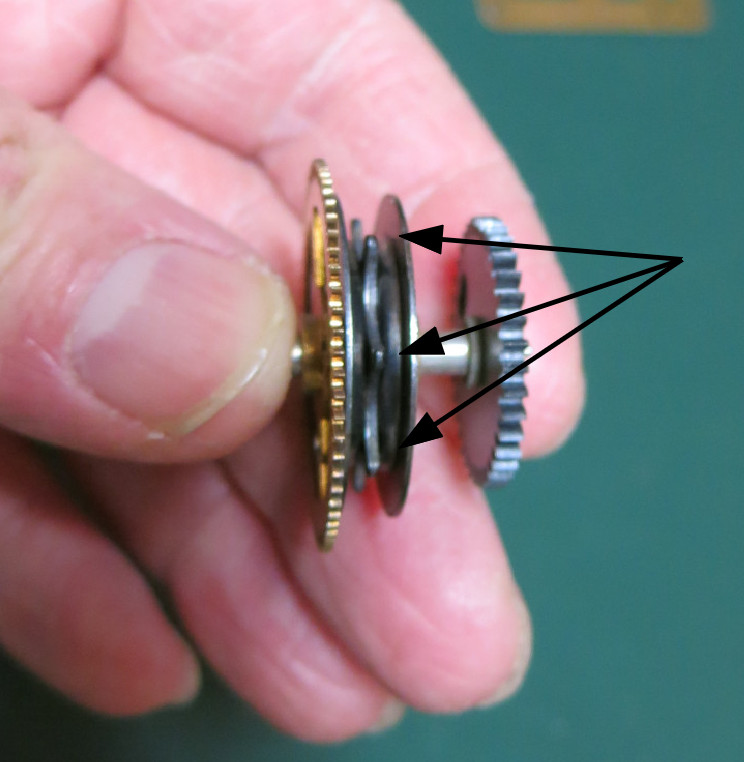Because of the economics of cuckoo clock repair, you can easily find old, dirty cuckoo clock movements on eBay for a fraction of what a new movement costs. These movements come with no documentation, so you get to work out which chains, weights, and bellows (cuckoo whistles) are right for them.
In this post I calculate the run time (1 day vs. 8 day) of a cuckoo movement I recently bought, and the Links Per Foot of the chain it uses. These two numbers tell me what parts to buy to make a clock case for this movement.
The economics of cuckoo clock repair are a bit odd: A new cuckoo clock movement costs about $70 USD; meanwhile, having a clock repairer fully clean a movement like this will cost at least $200. So, many clock repairers will swap out a dirty cuckoo movement for a new one rather than go to the expense – which they would have to pass on to the customer – of fully cleaning the dirty movement. Because of this swap, dirty but otherwise perfectly good cuckoo clock movements pile up in the clock repairer’s shop.
Often these dirty clock movements show up on eBay, listed as “cuckoo movement for parts or repair“. I imagine it’s a way for the clock repairer to recover a little of the cost of repair, and to clear out these old, dirty clock movements from their shop.
For the clock repair hobbyist, these dirty cuckoo movements provide a way to practice cuckoo clock repair on the cheap.
A short while ago I bought a rusty Regula 25 cuckoo clock movement on eBay for $26.95, with free shipping.

After the movement arrived, I disassembled it, gave the parts a good, gentle scrub with an SOS pad (a bad idea: crumbs of steel wool get everywhere), a brass brush, and water, then tossed them into the ultrasonic cleaner for 20 minutes at 25 degrees C, rinsed them in water, then wiped them with paper towels soaked in isopropyl alcohol to drive the water out of the parts.

While I had the movement apart, it was easy to calculate the ideal pendulum period by counting gear teeth.
In this case, I also wanted to know how much the time train great wheel – the wheel that will hold the time chain – revolved per hour, because that will tell me whether it’s a 1-day movement, or an 8-day movement.
Lucky for me, the great wheel on this clock directly drives the minute wheel, and the minute wheel has the same number of teeth (36) as the great wheel’s gear that drives the minute wheel. So the ratio of movement of the great wheel to the minute wheel is 36:36, which is 1:1. So the great wheel rotates once per rotation of the minute wheel: that is, once per hour.
So the great wheel on this clock makes one rotation per hour.
Next I needed to calculate the Links Per Foot of the ideal chain that will wrap over the great wheel and hold the time train weight.
The cuckoo movement’s great wheel contains a sprocket that hooks the links of the chain.


As you can see in the photos above, the cogs (teeth) of the great wheel’s sprocket hold every other link in the chain. I counted the cogs in the great wheel’s sprocket – 7 cogs – so one rotation of the great wheel will move 7 * 2 (14) links of the chain.
Now I knew the links-per-hour of the chain: 14 links per one rotation of the great wheel, which makes one turn per hour.
Next I needed the length of those 14 links, which is just the circumference of the circle formed by the chain on the great wheel.

It’s a bit of a guess to measure the diameter of the path of the chain. That diameter will be somewhere between the outside and inside diameters of the sprocket. Here I sort of eye-balled where I thought the chain would rest, and measured that diameter as about 21 mm.
Circumference = Pi * Diameter, so the circumference of this sprocket chain is about 3.14159 * 21, or about 66 mm. Converting to feet – because chain is sold in Links Per Foot (LPF) – that’s roughly 0.216 feet.
I knew the circumference of the great wheel sprocket holds 14 links of chain, and now I knew roughly what that circumference was, so I could calculate the rough Links Per Foot of the ideal chain for this clock: 14 / 0.216, or roughly 65 Links Per Foot.
Looking at the chains offered by one clock parts supplier, Timesavers.com, I found they sell chains with 61 and 72 Links Per Foot, so 61 Links Per Foot is likely the right number. Working backward from 61 Links Per Foot, 14 links (the circumference of the great wheel sprocket) are about 0.229 feet, or about 70 mm. Dividing by Pi gives the actual diameter of the sprocket chain: 22.28 mm; only a little larger than my measured diameter of 21.13 mm.
…also, Timesavers describes their 61 Links Per Foot, 70 inch chain as “Used on Regula #25, 1-day cuckoo clocks”. Because this movement is labeled a Regula #25, we’re in business!
Finally, I wanted to double-check that this clock movement is for a 1-day clock. Cuckoo clocks are usually mounted about 6 feet from the floor. 6 feet * 61 Links Per Foot = 366 links from the cuckoo clock to the floor.
Remember that the great wheel of this clock moves 14 links per hour. Dividing the length of the chain by the links moved per hour gives 366 / 14, or about 26 hours of chain. So the clock is a 1-day clock, and not an 8-day clock.
Armed with these numbers, I bought the 61 Links Per Foot, 70 inch long chain, which turned out to be exactly right. Math works!


